python學習——day9(ssh,線程和進程,信號量,隊列,生產者消費者模型) Alex地址:http://www.cnblogs.com/alex3714/articles/5230609.html
一、python上模擬ssh
1.ssh,ssh_ftp
pass
2.ssh 密鑰
pass
二、線程,進程
定義:
進程: 是對各種資源管理的集合,qq 要以一個整體的形式暴露給操作系統管理,裏面包含對各種資源的調用,內存的管理,網絡接口的調用等
線程: 是操作系統最小的調度單位, 是一串指令的集合。
進程要想操作CPU,就必須要創建一個線程(進程中至少包含一個線程)
區別:
1.線程共享內存空間(共享數據等),進程的內存空間是獨立的
2.同一進程的線程之間可以相互交流 ,2個進程之間的交流必須通過一個中間代理
3.線程可以操作和控制其他線程(同一進程下),進程只能操作和控制子進程。
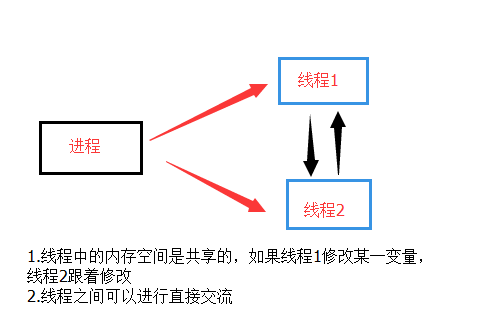
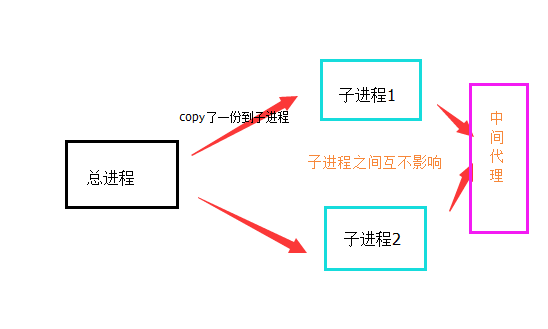
對主線程的更改可能會影響到其他線程的工作,對父進程的更改(除非關閉)不會影響子進程。(子進程還可以派生子進程)
各種鎖
1.線程鎖(我就瞎幾把寫了一下,具體代碼看這:http://www.cnblogs.com/alex3714/articles/5230609.html)
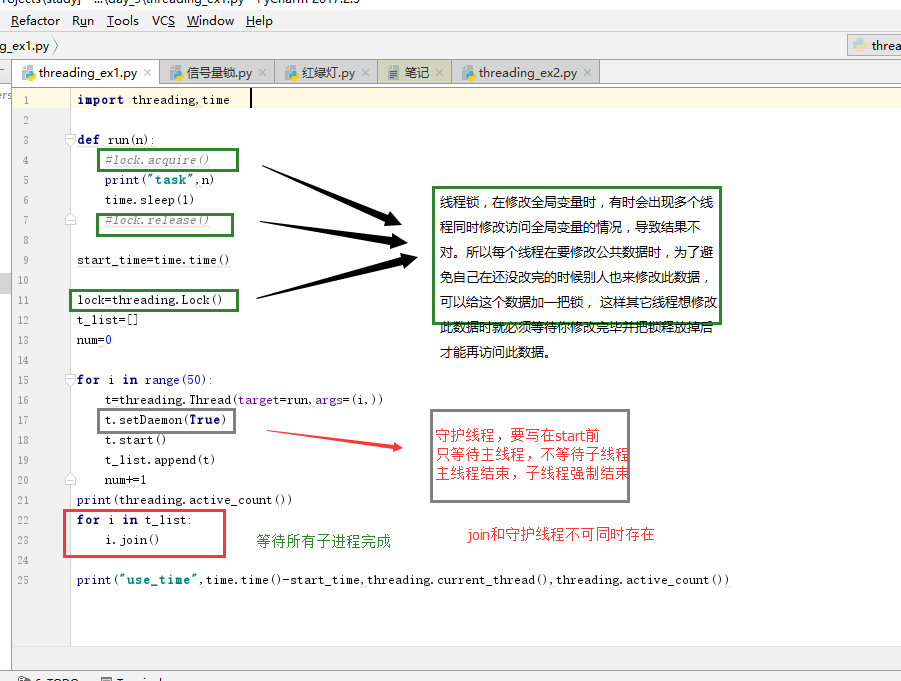
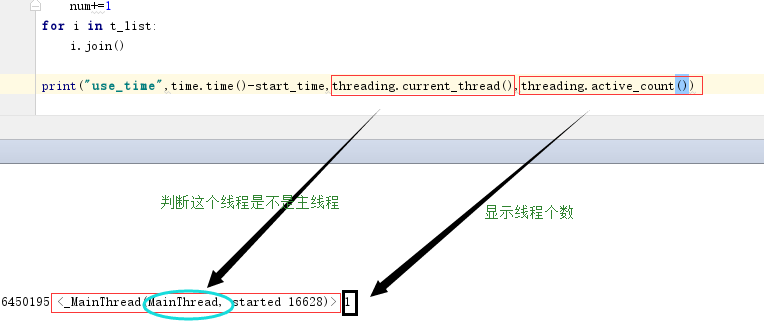
2.遞歸鎖(了解就行,一般用不到)
說白了就是在一個大鎖中還要再包含子鎖
1 import threading,time 2 3 4 5 def run1(): 6 7 print("grab the first part data") 8 9 lock.acquire()10 11 global num 12 13 num +=1 14 15 lock.release() 16 17 return num 18 19 def run2(): 20 21 print("grab the second part data") 22 23 lock.acquire() 24 25 global num2 26 27 num2+=1 28 29 lock.release() 30 31 return num2 32 33 def run3(): 34 35 lock.acquire()36 37 res = run1() 38 39 print(‘--------between run1 and run2-----‘) 40 41 res2 = run2() 42 43 lock.release() 44 45 print(res,res2) 46 47 48 49 50 51 if __name__ == ‘__main__‘: 52 53 54 55 num,num2 = 0,0 56 57 lock = threading.RLock() 58 59 for i in range(10): 60 61 t = threading.Thread(target=run3) 62 63 t.start() 64 65 66 67 while threading.active_count() != 1: 68 69 print(threading.active_count()) 70 71 else: 72 73 print(‘----all threads done---‘) 74 75 print(num,num2)
3.信號量鎖(Semaphore)
互斥鎖 同時只允許一個線程更改數據,而Semaphore是同時允許一定數量的線程更改數據 ,比如廁所有3個坑,那最多只允許3個人上廁所,後面的人只能等裏面有人出來了才能再進去。
1 import threading,time 2 3 def run(n): 4 semaphore.acquire() #信號量鎖 5 time.sleep(1) 6 print("run the:",n) 7 semaphore.release() #解鎖 8 9 10 if __name__==‘__main__‘: 11 semaphore=threading.BoundedSemaphore(5) #設定只有5個坑 12 for i in range(20): 13 t=threading.Thread(target=run,args=(i,)) 14 t.start() 15 16 while threading.active_count()!=1: 17 pass 18 else: 19 print(‘123‘)
信號量(event)
信號量只有設定(event.set())和沒設定(event.clear())兩種
event.wait() #等待設定
event.is_set() #判斷是否設定
紅綠燈例子
1 import time,threading 2 3 event = threading.Event() 4 5 def lighter(): 6 count=0 7 event.set() #設定 8 while True: 9 if count<10 and count>=5: 10 event.clear() #清除設定 11 print("\033[41;1m紅燈\033[0m") 12 time.sleep(1) 13 elif count>10: 14 count=0 15 event.set() 16 else: 17 print("\033[42;1m綠燈\033[0m") 18 time.sleep(1) 19 count+=1 20 21 def car(name): 22 while True: 23 if event.is_set(): #判斷是否設定 24 print("\033[32;1m[%s] run...\033[0m"%name) 25 time.sleep(1) 26 else: 27 print(‘\033[31;1m [%s] stop...‘%name) 28 event.wait() #等待設定 29 print(‘\033[33;1m [%s]走咯‘%name) 30 31 32 light=threading.Thread(target=lighter,) 33 34 light.start() 35 36 car1=threading.Thread(target=car,args=(‘Tesla‘,)) 37 38 car1.start()
未完待續
三、隊列(queue)
隊列的好處(作用):解耦,提高效率。
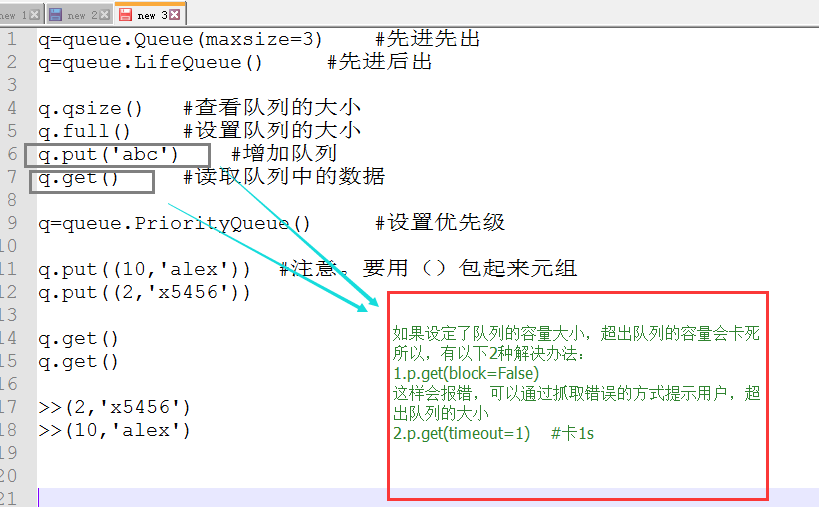
生產者消費者模型(很簡單,沒啥可說的)
1 import threading,time 2 3 import queue 4 5 q = queue.Queue(maxsize=10) 6 7 def Producer(name): 8 count = 1 9 while True: 10 q.put("骨頭%s" % count) 11 print("生產了骨頭",count) 12 count +=1 13 time.sleep(0.1) 14 15 16 17 def Consumer(name): 18 #while q.qsize()>0: 19 while True: 20 print("[%s] 取到[%s] 並且吃了它..." %(name, q.get())) 21 time.sleep(1) 22 23 24 25 p = threading.Thread(target=Producer,args=("Alex",)) 26 c = threading.Thread(target=Consumer,args=("ChengRonghua",)) 27 c1 = threading.Thread(target=Consumer,args=("王森",)) 28 29 30 p.start() 31 c.start() 32 c1.start()
python學習——day9(ssh,線程和進程,信號量,隊列,生產者消費者模型) Alex地址:http://www.cnblogs.com/alex3714/articles/5230609.html
